Situation Analysis of Google.org, James Houghton and Signature Theater, Trader Joe, Tesla Motors, and Apple
VerifiedAdded on 2022/12/14
|12
|4633
|217
AI Summary
This document provides a comprehensive situation analysis of Google.org, James Houghton and Signature Theater, Trader Joe, Tesla Motors, and Apple. It includes an analysis of strengths and weaknesses, day-to-day management, sustainability, success factors, strategy map, internal analysis, PEST assessment, competitive forces, and strategic implications.
Contribute Materials
Your contribution can guide someone’s learning journey. Share your
documents today.
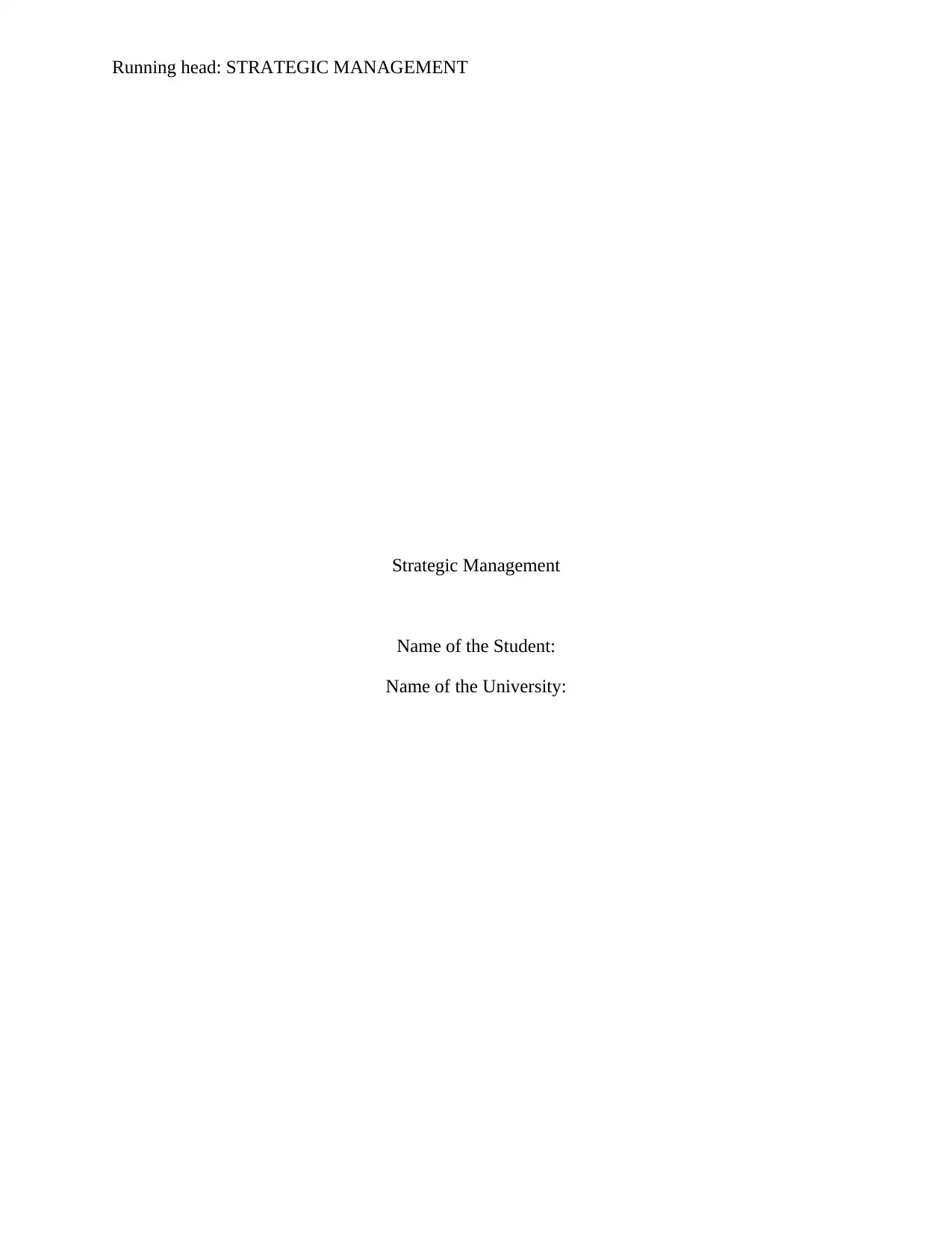
Running head: STRATEGIC MANAGEMENT
Strategic Management
Name of the Student:
Name of the University:
Strategic Management
Name of the Student:
Name of the University:
Secure Best Marks with AI Grader
Need help grading? Try our AI Grader for instant feedback on your assignments.
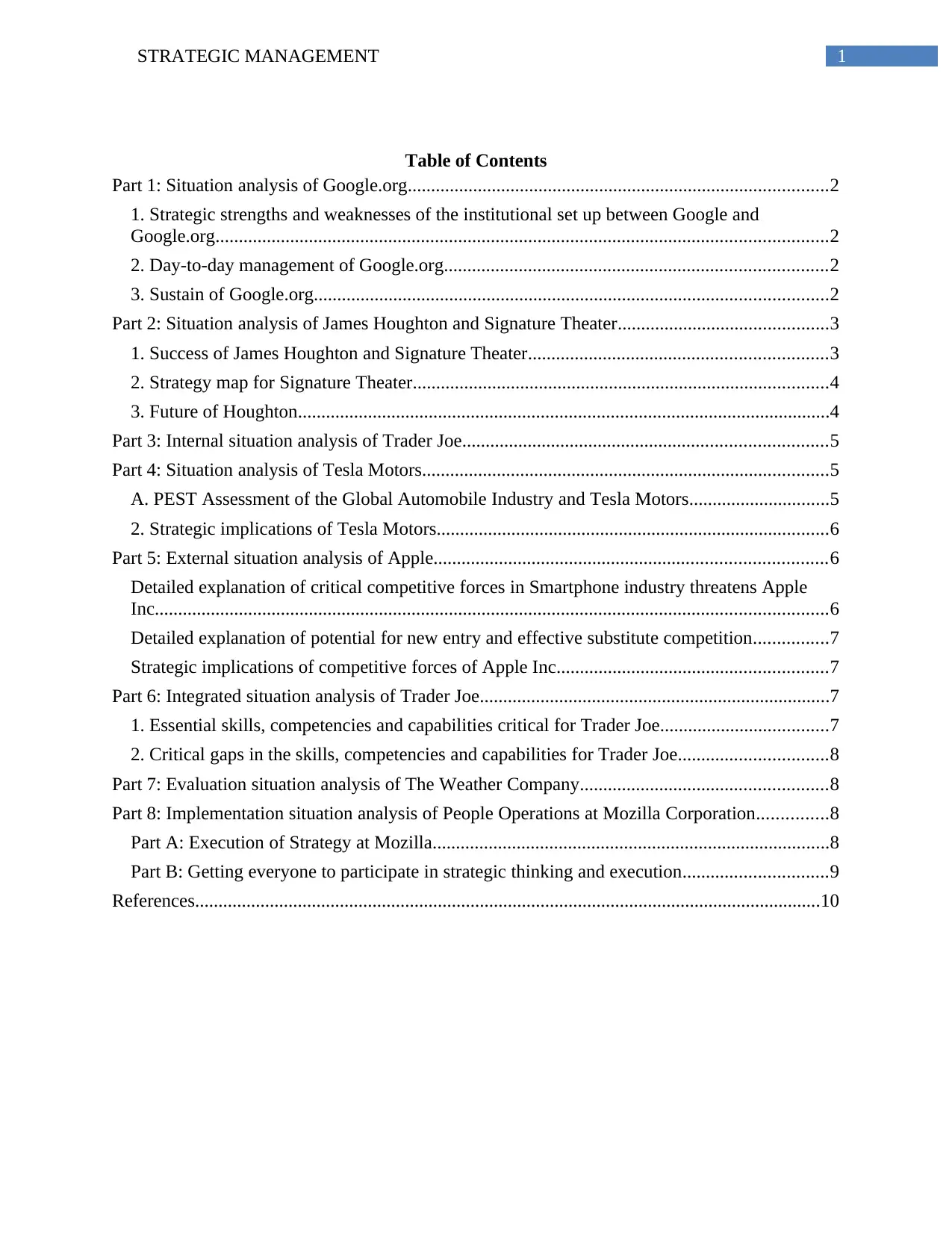
1STRATEGIC MANAGEMENT
Table of Contents
Part 1: Situation analysis of Google.org..........................................................................................2
1. Strategic strengths and weaknesses of the institutional set up between Google and
Google.org...................................................................................................................................2
2. Day-to-day management of Google.org..................................................................................2
3. Sustain of Google.org..............................................................................................................2
Part 2: Situation analysis of James Houghton and Signature Theater.............................................3
1. Success of James Houghton and Signature Theater................................................................3
2. Strategy map for Signature Theater.........................................................................................4
3. Future of Houghton..................................................................................................................4
Part 3: Internal situation analysis of Trader Joe..............................................................................5
Part 4: Situation analysis of Tesla Motors.......................................................................................5
A. PEST Assessment of the Global Automobile Industry and Tesla Motors..............................5
2. Strategic implications of Tesla Motors....................................................................................6
Part 5: External situation analysis of Apple....................................................................................6
Detailed explanation of critical competitive forces in Smartphone industry threatens Apple
Inc................................................................................................................................................6
Detailed explanation of potential for new entry and effective substitute competition................7
Strategic implications of competitive forces of Apple Inc..........................................................7
Part 6: Integrated situation analysis of Trader Joe...........................................................................7
1. Essential skills, competencies and capabilities critical for Trader Joe....................................7
2. Critical gaps in the skills, competencies and capabilities for Trader Joe................................8
Part 7: Evaluation situation analysis of The Weather Company.....................................................8
Part 8: Implementation situation analysis of People Operations at Mozilla Corporation...............8
Part A: Execution of Strategy at Mozilla.....................................................................................8
Part B: Getting everyone to participate in strategic thinking and execution...............................9
References......................................................................................................................................10
Table of Contents
Part 1: Situation analysis of Google.org..........................................................................................2
1. Strategic strengths and weaknesses of the institutional set up between Google and
Google.org...................................................................................................................................2
2. Day-to-day management of Google.org..................................................................................2
3. Sustain of Google.org..............................................................................................................2
Part 2: Situation analysis of James Houghton and Signature Theater.............................................3
1. Success of James Houghton and Signature Theater................................................................3
2. Strategy map for Signature Theater.........................................................................................4
3. Future of Houghton..................................................................................................................4
Part 3: Internal situation analysis of Trader Joe..............................................................................5
Part 4: Situation analysis of Tesla Motors.......................................................................................5
A. PEST Assessment of the Global Automobile Industry and Tesla Motors..............................5
2. Strategic implications of Tesla Motors....................................................................................6
Part 5: External situation analysis of Apple....................................................................................6
Detailed explanation of critical competitive forces in Smartphone industry threatens Apple
Inc................................................................................................................................................6
Detailed explanation of potential for new entry and effective substitute competition................7
Strategic implications of competitive forces of Apple Inc..........................................................7
Part 6: Integrated situation analysis of Trader Joe...........................................................................7
1. Essential skills, competencies and capabilities critical for Trader Joe....................................7
2. Critical gaps in the skills, competencies and capabilities for Trader Joe................................8
Part 7: Evaluation situation analysis of The Weather Company.....................................................8
Part 8: Implementation situation analysis of People Operations at Mozilla Corporation...............8
Part A: Execution of Strategy at Mozilla.....................................................................................8
Part B: Getting everyone to participate in strategic thinking and execution...............................9
References......................................................................................................................................10
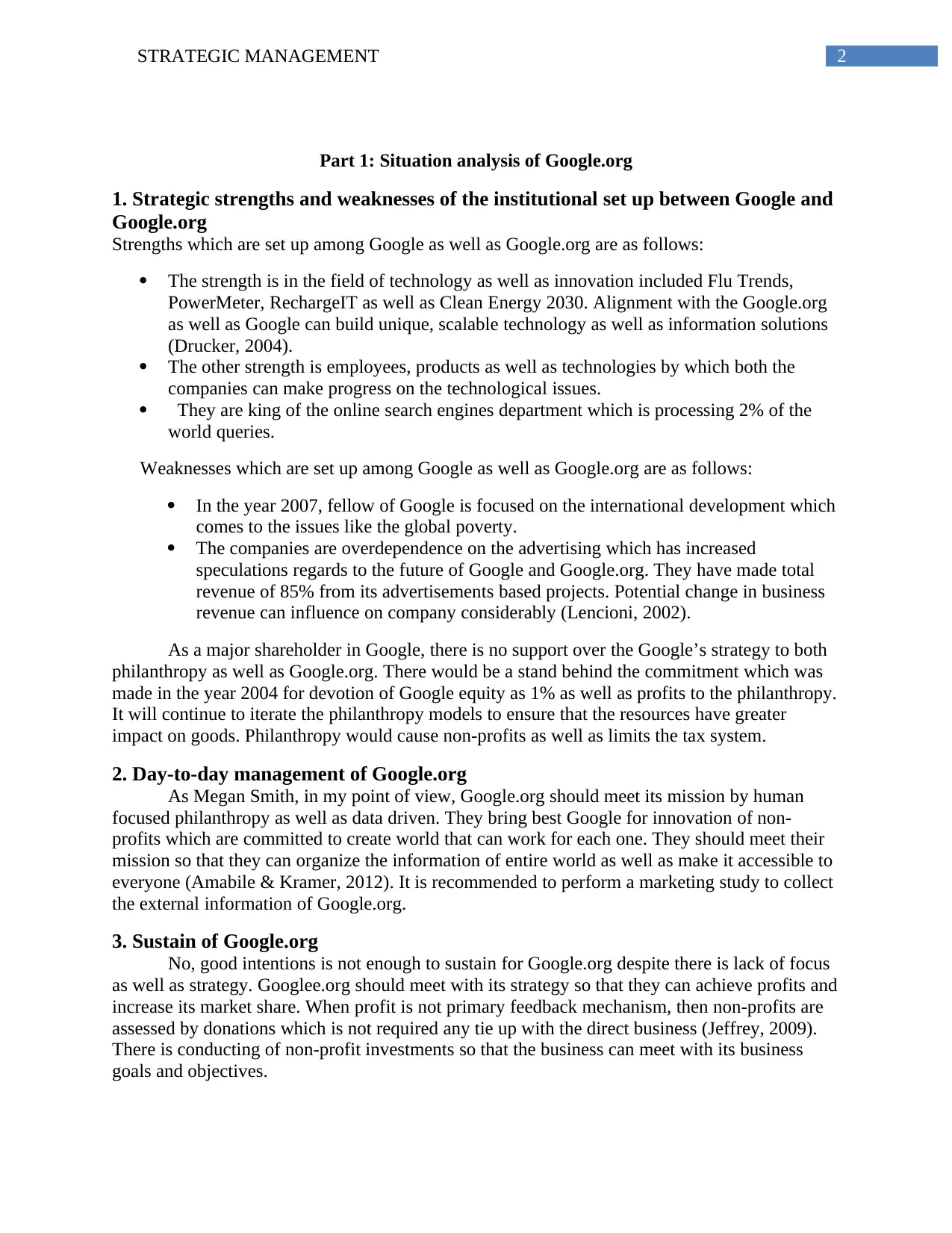
2STRATEGIC MANAGEMENT
Part 1: Situation analysis of Google.org
1. Strategic strengths and weaknesses of the institutional set up between Google and
Google.org
Strengths which are set up among Google as well as Google.org are as follows:
The strength is in the field of technology as well as innovation included Flu Trends,
PowerMeter, RechargeIT as well as Clean Energy 2030. Alignment with the Google.org
as well as Google can build unique, scalable technology as well as information solutions
(Drucker, 2004).
The other strength is employees, products as well as technologies by which both the
companies can make progress on the technological issues.
They are king of the online search engines department which is processing 2% of the
world queries.
Weaknesses which are set up among Google as well as Google.org are as follows:
In the year 2007, fellow of Google is focused on the international development which
comes to the issues like the global poverty.
The companies are overdependence on the advertising which has increased
speculations regards to the future of Google and Google.org. They have made total
revenue of 85% from its advertisements based projects. Potential change in business
revenue can influence on company considerably (Lencioni, 2002).
As a major shareholder in Google, there is no support over the Google’s strategy to both
philanthropy as well as Google.org. There would be a stand behind the commitment which was
made in the year 2004 for devotion of Google equity as 1% as well as profits to the philanthropy.
It will continue to iterate the philanthropy models to ensure that the resources have greater
impact on goods. Philanthropy would cause non-profits as well as limits the tax system.
2. Day-to-day management of Google.org
As Megan Smith, in my point of view, Google.org should meet its mission by human
focused philanthropy as well as data driven. They bring best Google for innovation of non-
profits which are committed to create world that can work for each one. They should meet their
mission so that they can organize the information of entire world as well as make it accessible to
everyone (Amabile & Kramer, 2012). It is recommended to perform a marketing study to collect
the external information of Google.org.
3. Sustain of Google.org
No, good intentions is not enough to sustain for Google.org despite there is lack of focus
as well as strategy. Googlee.org should meet with its strategy so that they can achieve profits and
increase its market share. When profit is not primary feedback mechanism, then non-profits are
assessed by donations which is not required any tie up with the direct business (Jeffrey, 2009).
There is conducting of non-profit investments so that the business can meet with its business
goals and objectives.
Part 1: Situation analysis of Google.org
1. Strategic strengths and weaknesses of the institutional set up between Google and
Google.org
Strengths which are set up among Google as well as Google.org are as follows:
The strength is in the field of technology as well as innovation included Flu Trends,
PowerMeter, RechargeIT as well as Clean Energy 2030. Alignment with the Google.org
as well as Google can build unique, scalable technology as well as information solutions
(Drucker, 2004).
The other strength is employees, products as well as technologies by which both the
companies can make progress on the technological issues.
They are king of the online search engines department which is processing 2% of the
world queries.
Weaknesses which are set up among Google as well as Google.org are as follows:
In the year 2007, fellow of Google is focused on the international development which
comes to the issues like the global poverty.
The companies are overdependence on the advertising which has increased
speculations regards to the future of Google and Google.org. They have made total
revenue of 85% from its advertisements based projects. Potential change in business
revenue can influence on company considerably (Lencioni, 2002).
As a major shareholder in Google, there is no support over the Google’s strategy to both
philanthropy as well as Google.org. There would be a stand behind the commitment which was
made in the year 2004 for devotion of Google equity as 1% as well as profits to the philanthropy.
It will continue to iterate the philanthropy models to ensure that the resources have greater
impact on goods. Philanthropy would cause non-profits as well as limits the tax system.
2. Day-to-day management of Google.org
As Megan Smith, in my point of view, Google.org should meet its mission by human
focused philanthropy as well as data driven. They bring best Google for innovation of non-
profits which are committed to create world that can work for each one. They should meet their
mission so that they can organize the information of entire world as well as make it accessible to
everyone (Amabile & Kramer, 2012). It is recommended to perform a marketing study to collect
the external information of Google.org.
3. Sustain of Google.org
No, good intentions is not enough to sustain for Google.org despite there is lack of focus
as well as strategy. Googlee.org should meet with its strategy so that they can achieve profits and
increase its market share. When profit is not primary feedback mechanism, then non-profits are
assessed by donations which is not required any tie up with the direct business (Jeffrey, 2009).
There is conducting of non-profit investments so that the business can meet with its business
goals and objectives.
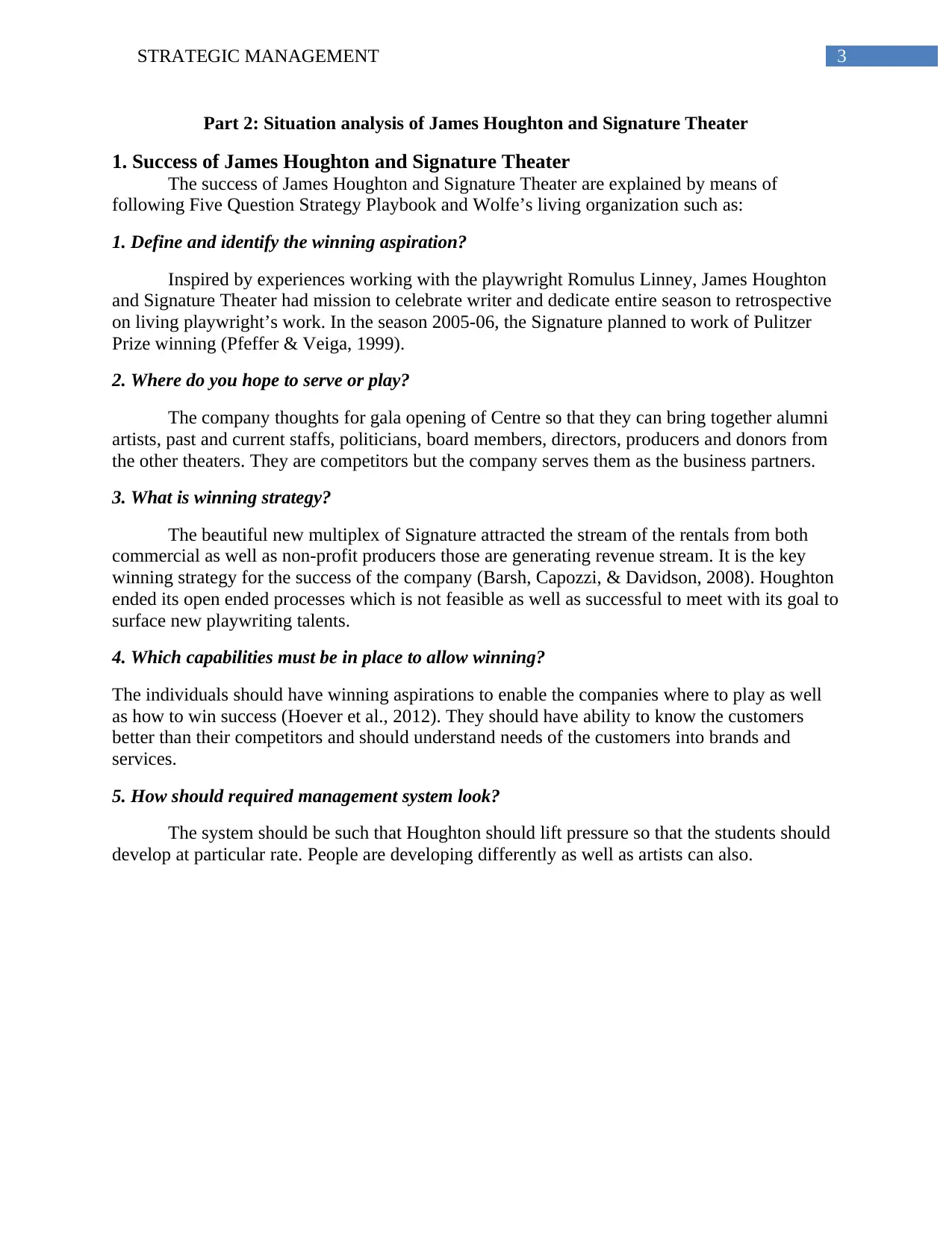
3STRATEGIC MANAGEMENT
Part 2: Situation analysis of James Houghton and Signature Theater
1. Success of James Houghton and Signature Theater
The success of James Houghton and Signature Theater are explained by means of
following Five Question Strategy Playbook and Wolfe’s living organization such as:
1. Define and identify the winning aspiration?
Inspired by experiences working with the playwright Romulus Linney, James Houghton
and Signature Theater had mission to celebrate writer and dedicate entire season to retrospective
on living playwright’s work. In the season 2005-06, the Signature planned to work of Pulitzer
Prize winning (Pfeffer & Veiga, 1999).
2. Where do you hope to serve or play?
The company thoughts for gala opening of Centre so that they can bring together alumni
artists, past and current staffs, politicians, board members, directors, producers and donors from
the other theaters. They are competitors but the company serves them as the business partners.
3. What is winning strategy?
The beautiful new multiplex of Signature attracted the stream of the rentals from both
commercial as well as non-profit producers those are generating revenue stream. It is the key
winning strategy for the success of the company (Barsh, Capozzi, & Davidson, 2008). Houghton
ended its open ended processes which is not feasible as well as successful to meet with its goal to
surface new playwriting talents.
4. Which capabilities must be in place to allow winning?
The individuals should have winning aspirations to enable the companies where to play as well
as how to win success (Hoever et al., 2012). They should have ability to know the customers
better than their competitors and should understand needs of the customers into brands and
services.
5. How should required management system look?
The system should be such that Houghton should lift pressure so that the students should
develop at particular rate. People are developing differently as well as artists can also.
Part 2: Situation analysis of James Houghton and Signature Theater
1. Success of James Houghton and Signature Theater
The success of James Houghton and Signature Theater are explained by means of
following Five Question Strategy Playbook and Wolfe’s living organization such as:
1. Define and identify the winning aspiration?
Inspired by experiences working with the playwright Romulus Linney, James Houghton
and Signature Theater had mission to celebrate writer and dedicate entire season to retrospective
on living playwright’s work. In the season 2005-06, the Signature planned to work of Pulitzer
Prize winning (Pfeffer & Veiga, 1999).
2. Where do you hope to serve or play?
The company thoughts for gala opening of Centre so that they can bring together alumni
artists, past and current staffs, politicians, board members, directors, producers and donors from
the other theaters. They are competitors but the company serves them as the business partners.
3. What is winning strategy?
The beautiful new multiplex of Signature attracted the stream of the rentals from both
commercial as well as non-profit producers those are generating revenue stream. It is the key
winning strategy for the success of the company (Barsh, Capozzi, & Davidson, 2008). Houghton
ended its open ended processes which is not feasible as well as successful to meet with its goal to
surface new playwriting talents.
4. Which capabilities must be in place to allow winning?
The individuals should have winning aspirations to enable the companies where to play as well
as how to win success (Hoever et al., 2012). They should have ability to know the customers
better than their competitors and should understand needs of the customers into brands and
services.
5. How should required management system look?
The system should be such that Houghton should lift pressure so that the students should
develop at particular rate. People are developing differently as well as artists can also.
Secure Best Marks with AI Grader
Need help grading? Try our AI Grader for instant feedback on your assignments.
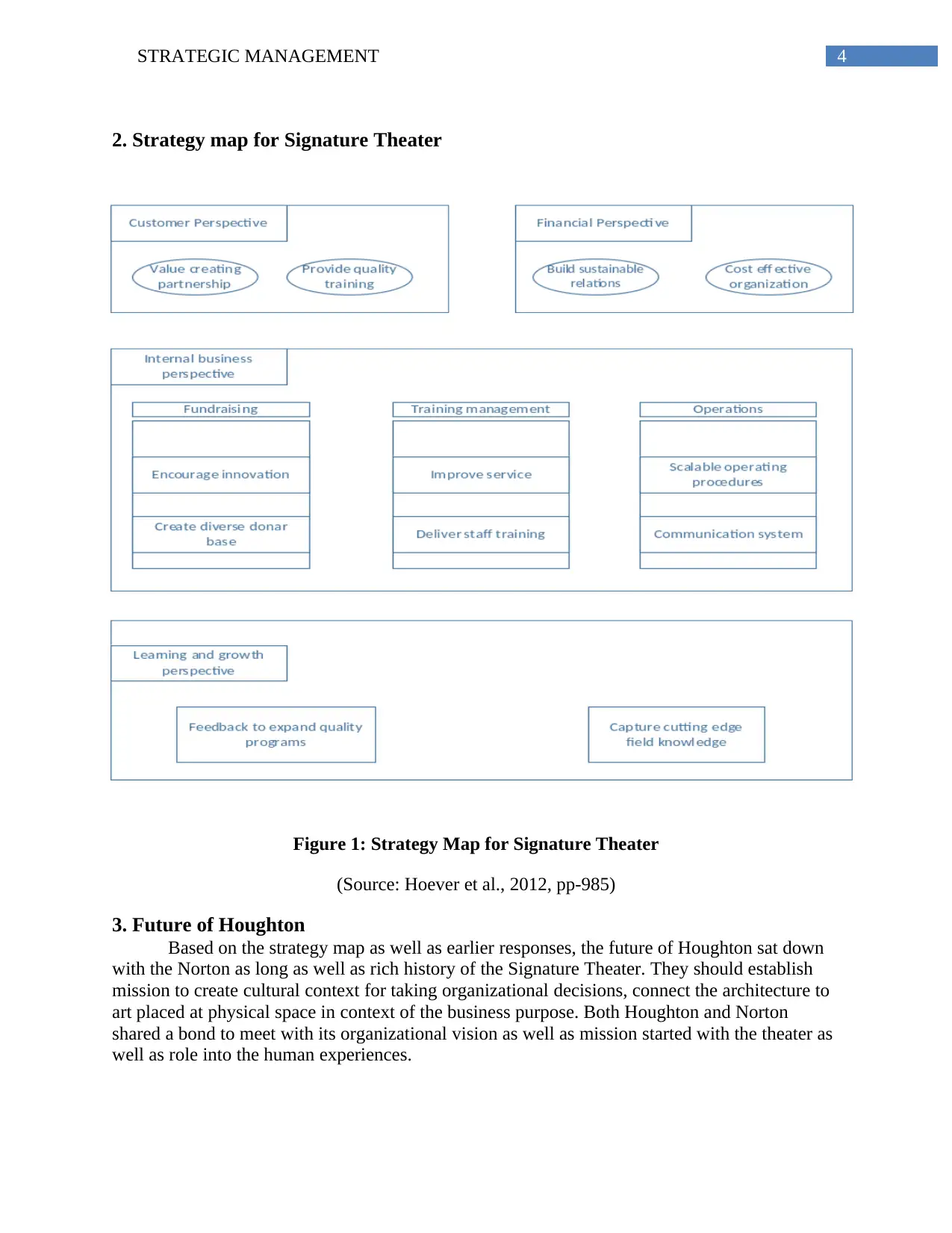
4STRATEGIC MANAGEMENT
2. Strategy map for Signature Theater
Figure 1: Strategy Map for Signature Theater
(Source: Hoever et al., 2012, pp-985)
3. Future of Houghton
Based on the strategy map as well as earlier responses, the future of Houghton sat down
with the Norton as long as well as rich history of the Signature Theater. They should establish
mission to create cultural context for taking organizational decisions, connect the architecture to
art placed at physical space in context of the business purpose. Both Houghton and Norton
shared a bond to meet with its organizational vision as well as mission started with the theater as
well as role into the human experiences.
2. Strategy map for Signature Theater
Figure 1: Strategy Map for Signature Theater
(Source: Hoever et al., 2012, pp-985)
3. Future of Houghton
Based on the strategy map as well as earlier responses, the future of Houghton sat down
with the Norton as long as well as rich history of the Signature Theater. They should establish
mission to create cultural context for taking organizational decisions, connect the architecture to
art placed at physical space in context of the business purpose. Both Houghton and Norton
shared a bond to meet with its organizational vision as well as mission started with the theater as
well as role into the human experiences.
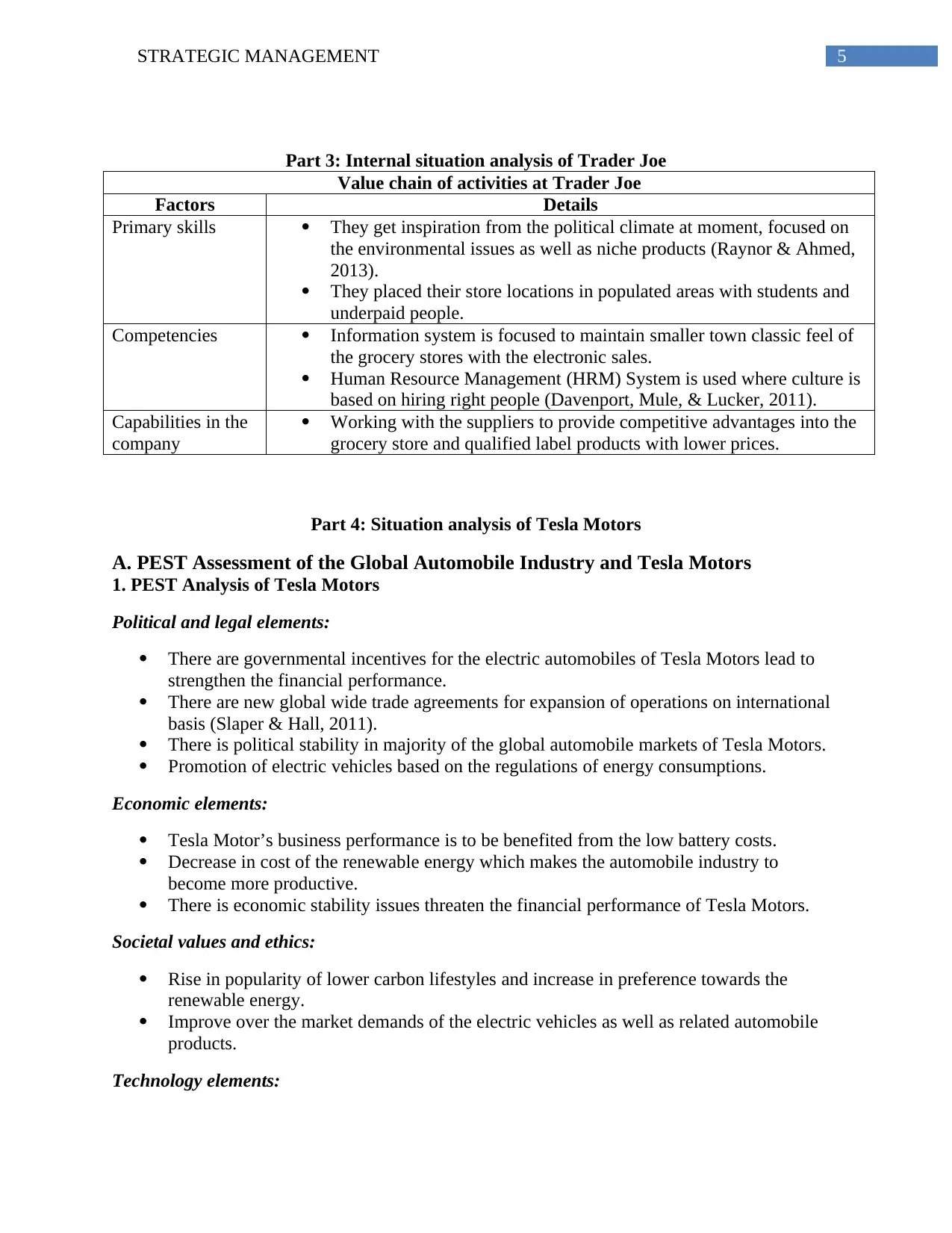
5STRATEGIC MANAGEMENT
Part 3: Internal situation analysis of Trader Joe
Value chain of activities at Trader Joe
Factors Details
Primary skills They get inspiration from the political climate at moment, focused on
the environmental issues as well as niche products (Raynor & Ahmed,
2013).
They placed their store locations in populated areas with students and
underpaid people.
Competencies Information system is focused to maintain smaller town classic feel of
the grocery stores with the electronic sales.
Human Resource Management (HRM) System is used where culture is
based on hiring right people (Davenport, Mule, & Lucker, 2011).
Capabilities in the
company
Working with the suppliers to provide competitive advantages into the
grocery store and qualified label products with lower prices.
Part 4: Situation analysis of Tesla Motors
A. PEST Assessment of the Global Automobile Industry and Tesla Motors
1. PEST Analysis of Tesla Motors
Political and legal elements:
There are governmental incentives for the electric automobiles of Tesla Motors lead to
strengthen the financial performance.
There are new global wide trade agreements for expansion of operations on international
basis (Slaper & Hall, 2011).
There is political stability in majority of the global automobile markets of Tesla Motors.
Promotion of electric vehicles based on the regulations of energy consumptions.
Economic elements:
Tesla Motor’s business performance is to be benefited from the low battery costs.
Decrease in cost of the renewable energy which makes the automobile industry to
become more productive.
There is economic stability issues threaten the financial performance of Tesla Motors.
Societal values and ethics:
Rise in popularity of lower carbon lifestyles and increase in preference towards the
renewable energy.
Improve over the market demands of the electric vehicles as well as related automobile
products.
Technology elements:
Part 3: Internal situation analysis of Trader Joe
Value chain of activities at Trader Joe
Factors Details
Primary skills They get inspiration from the political climate at moment, focused on
the environmental issues as well as niche products (Raynor & Ahmed,
2013).
They placed their store locations in populated areas with students and
underpaid people.
Competencies Information system is focused to maintain smaller town classic feel of
the grocery stores with the electronic sales.
Human Resource Management (HRM) System is used where culture is
based on hiring right people (Davenport, Mule, & Lucker, 2011).
Capabilities in the
company
Working with the suppliers to provide competitive advantages into the
grocery store and qualified label products with lower prices.
Part 4: Situation analysis of Tesla Motors
A. PEST Assessment of the Global Automobile Industry and Tesla Motors
1. PEST Analysis of Tesla Motors
Political and legal elements:
There are governmental incentives for the electric automobiles of Tesla Motors lead to
strengthen the financial performance.
There are new global wide trade agreements for expansion of operations on international
basis (Slaper & Hall, 2011).
There is political stability in majority of the global automobile markets of Tesla Motors.
Promotion of electric vehicles based on the regulations of energy consumptions.
Economic elements:
Tesla Motor’s business performance is to be benefited from the low battery costs.
Decrease in cost of the renewable energy which makes the automobile industry to
become more productive.
There is economic stability issues threaten the financial performance of Tesla Motors.
Societal values and ethics:
Rise in popularity of lower carbon lifestyles and increase in preference towards the
renewable energy.
Improve over the market demands of the electric vehicles as well as related automobile
products.
Technology elements:
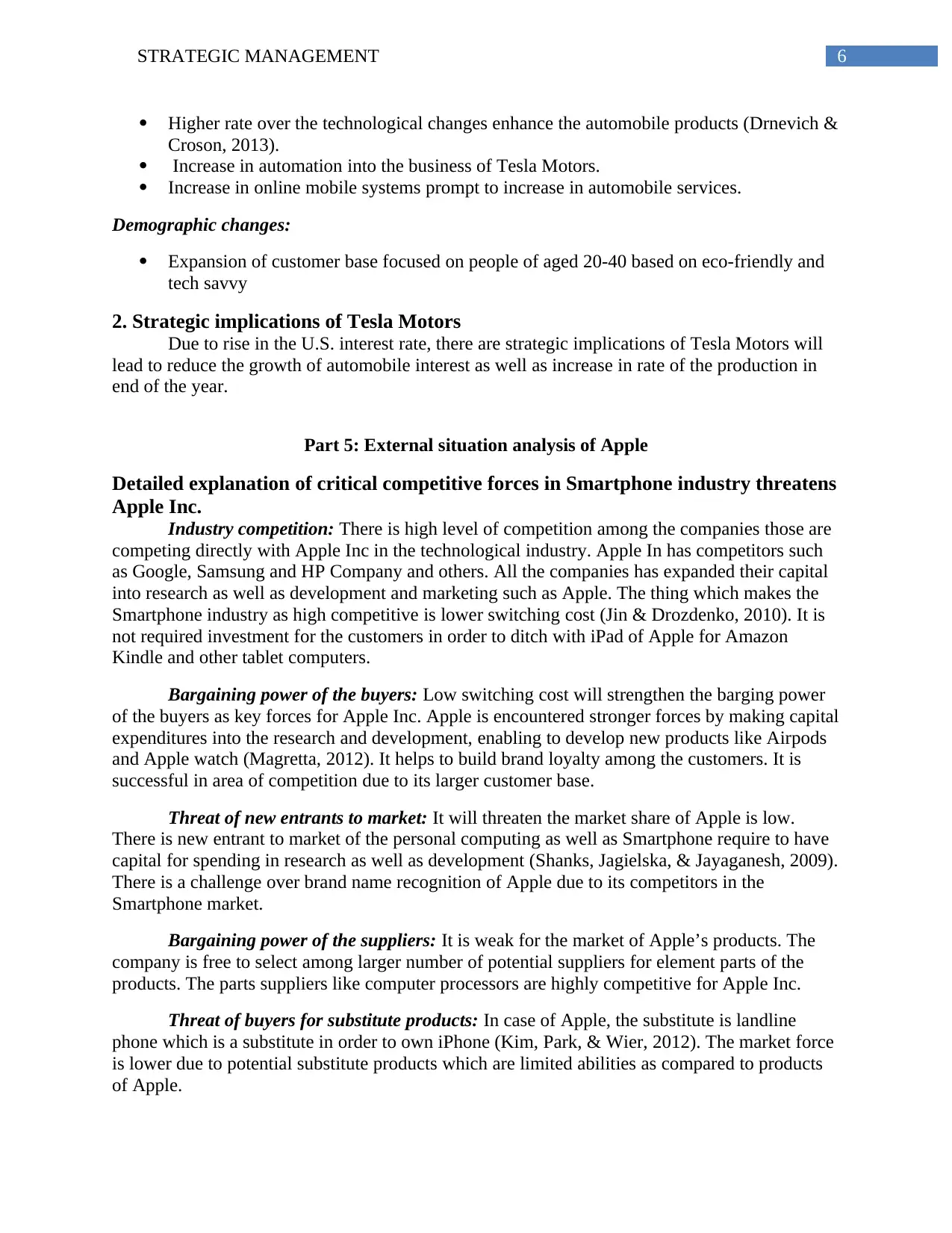
6STRATEGIC MANAGEMENT
Higher rate over the technological changes enhance the automobile products (Drnevich &
Croson, 2013).
Increase in automation into the business of Tesla Motors.
Increase in online mobile systems prompt to increase in automobile services.
Demographic changes:
Expansion of customer base focused on people of aged 20-40 based on eco-friendly and
tech savvy
2. Strategic implications of Tesla Motors
Due to rise in the U.S. interest rate, there are strategic implications of Tesla Motors will
lead to reduce the growth of automobile interest as well as increase in rate of the production in
end of the year.
Part 5: External situation analysis of Apple
Detailed explanation of critical competitive forces in Smartphone industry threatens
Apple Inc.
Industry competition: There is high level of competition among the companies those are
competing directly with Apple Inc in the technological industry. Apple In has competitors such
as Google, Samsung and HP Company and others. All the companies has expanded their capital
into research as well as development and marketing such as Apple. The thing which makes the
Smartphone industry as high competitive is lower switching cost (Jin & Drozdenko, 2010). It is
not required investment for the customers in order to ditch with iPad of Apple for Amazon
Kindle and other tablet computers.
Bargaining power of the buyers: Low switching cost will strengthen the barging power
of the buyers as key forces for Apple Inc. Apple is encountered stronger forces by making capital
expenditures into the research and development, enabling to develop new products like Airpods
and Apple watch (Magretta, 2012). It helps to build brand loyalty among the customers. It is
successful in area of competition due to its larger customer base.
Threat of new entrants to market: It will threaten the market share of Apple is low.
There is new entrant to market of the personal computing as well as Smartphone require to have
capital for spending in research as well as development (Shanks, Jagielska, & Jayaganesh, 2009).
There is a challenge over brand name recognition of Apple due to its competitors in the
Smartphone market.
Bargaining power of the suppliers: It is weak for the market of Apple’s products. The
company is free to select among larger number of potential suppliers for element parts of the
products. The parts suppliers like computer processors are highly competitive for Apple Inc.
Threat of buyers for substitute products: In case of Apple, the substitute is landline
phone which is a substitute in order to own iPhone (Kim, Park, & Wier, 2012). The market force
is lower due to potential substitute products which are limited abilities as compared to products
of Apple.
Higher rate over the technological changes enhance the automobile products (Drnevich &
Croson, 2013).
Increase in automation into the business of Tesla Motors.
Increase in online mobile systems prompt to increase in automobile services.
Demographic changes:
Expansion of customer base focused on people of aged 20-40 based on eco-friendly and
tech savvy
2. Strategic implications of Tesla Motors
Due to rise in the U.S. interest rate, there are strategic implications of Tesla Motors will
lead to reduce the growth of automobile interest as well as increase in rate of the production in
end of the year.
Part 5: External situation analysis of Apple
Detailed explanation of critical competitive forces in Smartphone industry threatens
Apple Inc.
Industry competition: There is high level of competition among the companies those are
competing directly with Apple Inc in the technological industry. Apple In has competitors such
as Google, Samsung and HP Company and others. All the companies has expanded their capital
into research as well as development and marketing such as Apple. The thing which makes the
Smartphone industry as high competitive is lower switching cost (Jin & Drozdenko, 2010). It is
not required investment for the customers in order to ditch with iPad of Apple for Amazon
Kindle and other tablet computers.
Bargaining power of the buyers: Low switching cost will strengthen the barging power
of the buyers as key forces for Apple Inc. Apple is encountered stronger forces by making capital
expenditures into the research and development, enabling to develop new products like Airpods
and Apple watch (Magretta, 2012). It helps to build brand loyalty among the customers. It is
successful in area of competition due to its larger customer base.
Threat of new entrants to market: It will threaten the market share of Apple is low.
There is new entrant to market of the personal computing as well as Smartphone require to have
capital for spending in research as well as development (Shanks, Jagielska, & Jayaganesh, 2009).
There is a challenge over brand name recognition of Apple due to its competitors in the
Smartphone market.
Bargaining power of the suppliers: It is weak for the market of Apple’s products. The
company is free to select among larger number of potential suppliers for element parts of the
products. The parts suppliers like computer processors are highly competitive for Apple Inc.
Threat of buyers for substitute products: In case of Apple, the substitute is landline
phone which is a substitute in order to own iPhone (Kim, Park, & Wier, 2012). The market force
is lower due to potential substitute products which are limited abilities as compared to products
of Apple.
Paraphrase This Document
Need a fresh take? Get an instant paraphrase of this document with our AI Paraphraser
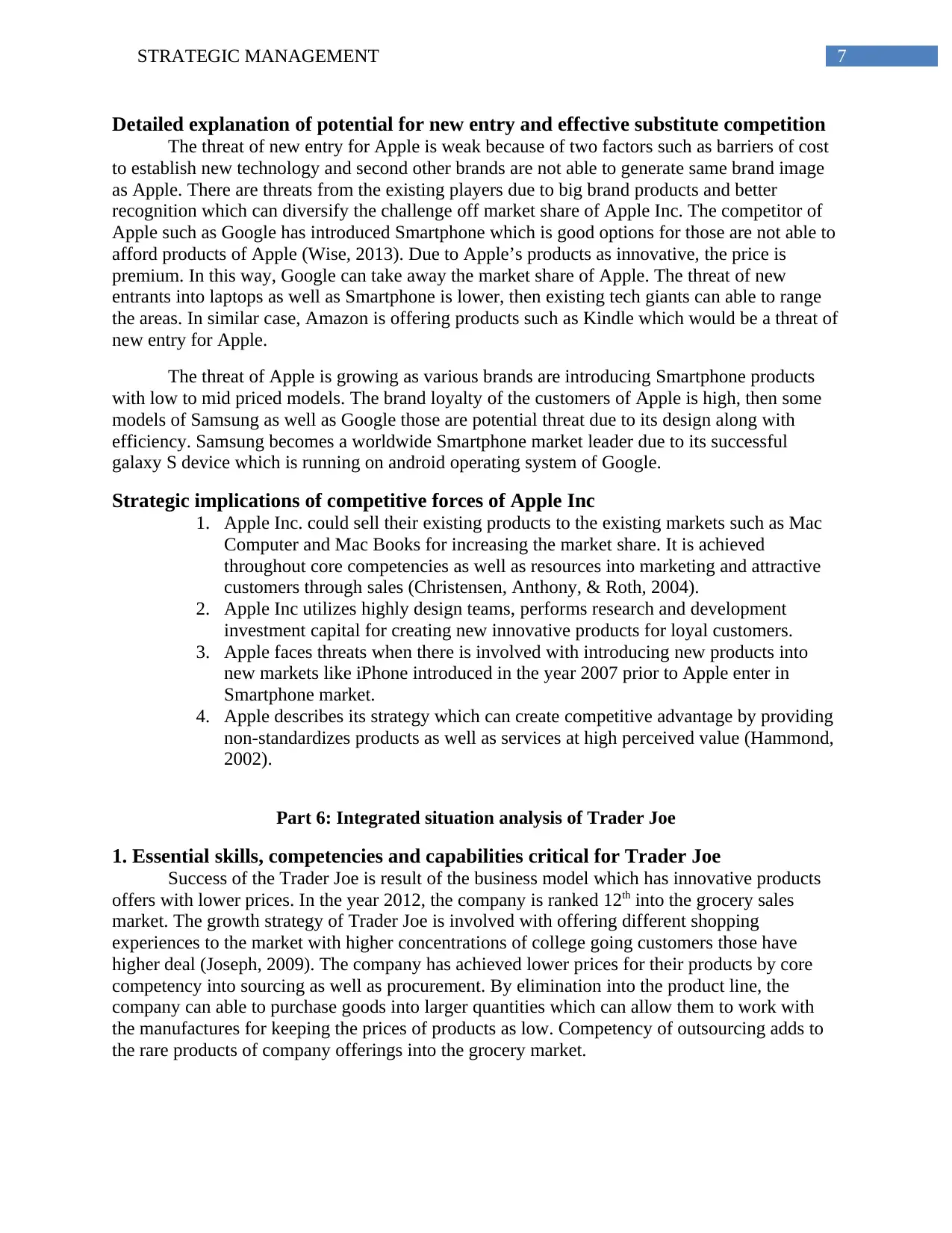
7STRATEGIC MANAGEMENT
Detailed explanation of potential for new entry and effective substitute competition
The threat of new entry for Apple is weak because of two factors such as barriers of cost
to establish new technology and second other brands are not able to generate same brand image
as Apple. There are threats from the existing players due to big brand products and better
recognition which can diversify the challenge off market share of Apple Inc. The competitor of
Apple such as Google has introduced Smartphone which is good options for those are not able to
afford products of Apple (Wise, 2013). Due to Apple’s products as innovative, the price is
premium. In this way, Google can take away the market share of Apple. The threat of new
entrants into laptops as well as Smartphone is lower, then existing tech giants can able to range
the areas. In similar case, Amazon is offering products such as Kindle which would be a threat of
new entry for Apple.
The threat of Apple is growing as various brands are introducing Smartphone products
with low to mid priced models. The brand loyalty of the customers of Apple is high, then some
models of Samsung as well as Google those are potential threat due to its design along with
efficiency. Samsung becomes a worldwide Smartphone market leader due to its successful
galaxy S device which is running on android operating system of Google.
Strategic implications of competitive forces of Apple Inc
1. Apple Inc. could sell their existing products to the existing markets such as Mac
Computer and Mac Books for increasing the market share. It is achieved
throughout core competencies as well as resources into marketing and attractive
customers through sales (Christensen, Anthony, & Roth, 2004).
2. Apple Inc utilizes highly design teams, performs research and development
investment capital for creating new innovative products for loyal customers.
3. Apple faces threats when there is involved with introducing new products into
new markets like iPhone introduced in the year 2007 prior to Apple enter in
Smartphone market.
4. Apple describes its strategy which can create competitive advantage by providing
non-standardizes products as well as services at high perceived value (Hammond,
2002).
Part 6: Integrated situation analysis of Trader Joe
1. Essential skills, competencies and capabilities critical for Trader Joe
Success of the Trader Joe is result of the business model which has innovative products
offers with lower prices. In the year 2012, the company is ranked 12th into the grocery sales
market. The growth strategy of Trader Joe is involved with offering different shopping
experiences to the market with higher concentrations of college going customers those have
higher deal (Joseph, 2009). The company has achieved lower prices for their products by core
competency into sourcing as well as procurement. By elimination into the product line, the
company can able to purchase goods into larger quantities which can allow them to work with
the manufactures for keeping the prices of products as low. Competency of outsourcing adds to
the rare products of company offerings into the grocery market.
Detailed explanation of potential for new entry and effective substitute competition
The threat of new entry for Apple is weak because of two factors such as barriers of cost
to establish new technology and second other brands are not able to generate same brand image
as Apple. There are threats from the existing players due to big brand products and better
recognition which can diversify the challenge off market share of Apple Inc. The competitor of
Apple such as Google has introduced Smartphone which is good options for those are not able to
afford products of Apple (Wise, 2013). Due to Apple’s products as innovative, the price is
premium. In this way, Google can take away the market share of Apple. The threat of new
entrants into laptops as well as Smartphone is lower, then existing tech giants can able to range
the areas. In similar case, Amazon is offering products such as Kindle which would be a threat of
new entry for Apple.
The threat of Apple is growing as various brands are introducing Smartphone products
with low to mid priced models. The brand loyalty of the customers of Apple is high, then some
models of Samsung as well as Google those are potential threat due to its design along with
efficiency. Samsung becomes a worldwide Smartphone market leader due to its successful
galaxy S device which is running on android operating system of Google.
Strategic implications of competitive forces of Apple Inc
1. Apple Inc. could sell their existing products to the existing markets such as Mac
Computer and Mac Books for increasing the market share. It is achieved
throughout core competencies as well as resources into marketing and attractive
customers through sales (Christensen, Anthony, & Roth, 2004).
2. Apple Inc utilizes highly design teams, performs research and development
investment capital for creating new innovative products for loyal customers.
3. Apple faces threats when there is involved with introducing new products into
new markets like iPhone introduced in the year 2007 prior to Apple enter in
Smartphone market.
4. Apple describes its strategy which can create competitive advantage by providing
non-standardizes products as well as services at high perceived value (Hammond,
2002).
Part 6: Integrated situation analysis of Trader Joe
1. Essential skills, competencies and capabilities critical for Trader Joe
Success of the Trader Joe is result of the business model which has innovative products
offers with lower prices. In the year 2012, the company is ranked 12th into the grocery sales
market. The growth strategy of Trader Joe is involved with offering different shopping
experiences to the market with higher concentrations of college going customers those have
higher deal (Joseph, 2009). The company has achieved lower prices for their products by core
competency into sourcing as well as procurement. By elimination into the product line, the
company can able to purchase goods into larger quantities which can allow them to work with
the manufactures for keeping the prices of products as low. Competency of outsourcing adds to
the rare products of company offerings into the grocery market.
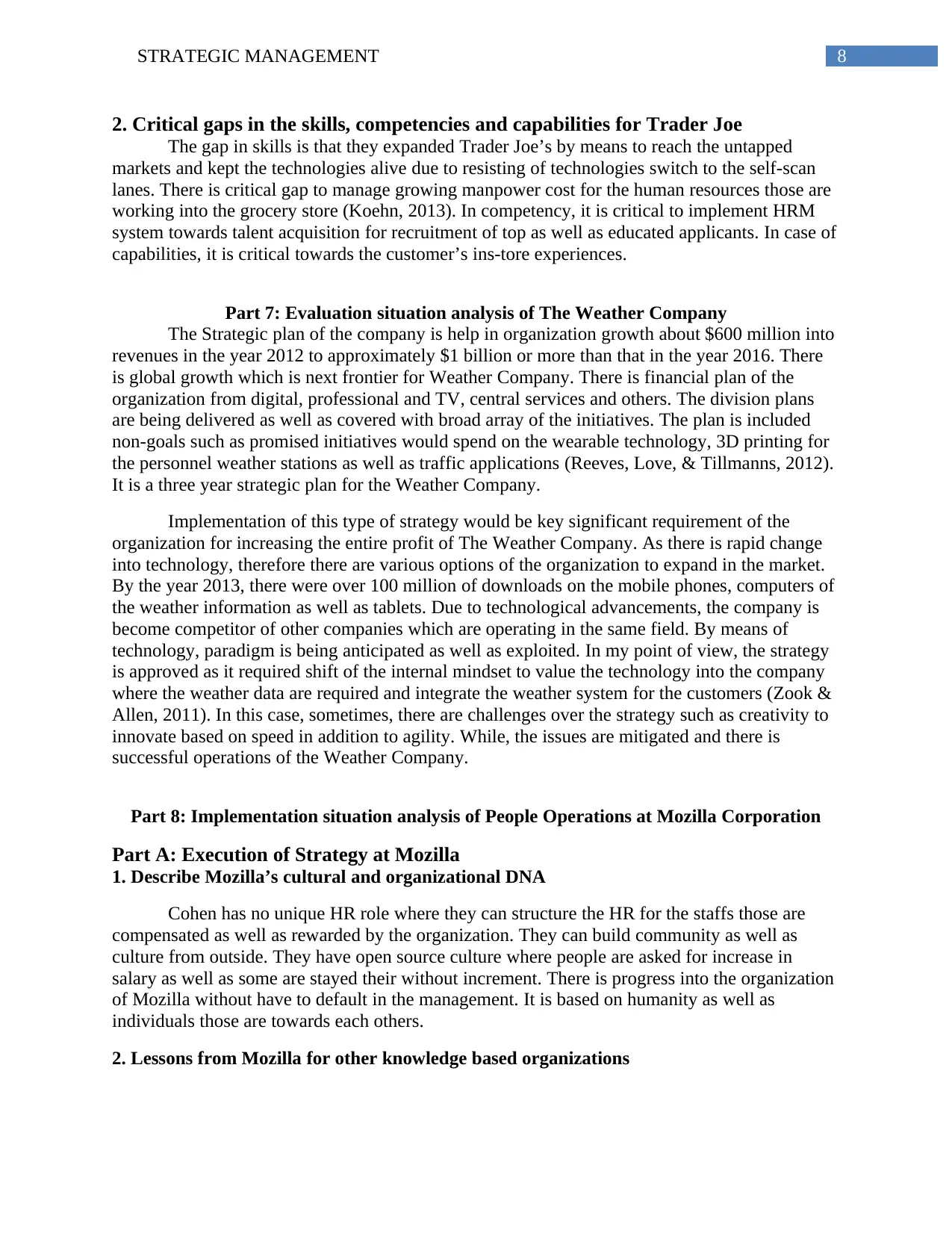
8STRATEGIC MANAGEMENT
2. Critical gaps in the skills, competencies and capabilities for Trader Joe
The gap in skills is that they expanded Trader Joe’s by means to reach the untapped
markets and kept the technologies alive due to resisting of technologies switch to the self-scan
lanes. There is critical gap to manage growing manpower cost for the human resources those are
working into the grocery store (Koehn, 2013). In competency, it is critical to implement HRM
system towards talent acquisition for recruitment of top as well as educated applicants. In case of
capabilities, it is critical towards the customer’s ins-tore experiences.
Part 7: Evaluation situation analysis of The Weather Company
The Strategic plan of the company is help in organization growth about $600 million into
revenues in the year 2012 to approximately $1 billion or more than that in the year 2016. There
is global growth which is next frontier for Weather Company. There is financial plan of the
organization from digital, professional and TV, central services and others. The division plans
are being delivered as well as covered with broad array of the initiatives. The plan is included
non-goals such as promised initiatives would spend on the wearable technology, 3D printing for
the personnel weather stations as well as traffic applications (Reeves, Love, & Tillmanns, 2012).
It is a three year strategic plan for the Weather Company.
Implementation of this type of strategy would be key significant requirement of the
organization for increasing the entire profit of The Weather Company. As there is rapid change
into technology, therefore there are various options of the organization to expand in the market.
By the year 2013, there were over 100 million of downloads on the mobile phones, computers of
the weather information as well as tablets. Due to technological advancements, the company is
become competitor of other companies which are operating in the same field. By means of
technology, paradigm is being anticipated as well as exploited. In my point of view, the strategy
is approved as it required shift of the internal mindset to value the technology into the company
where the weather data are required and integrate the weather system for the customers (Zook &
Allen, 2011). In this case, sometimes, there are challenges over the strategy such as creativity to
innovate based on speed in addition to agility. While, the issues are mitigated and there is
successful operations of the Weather Company.
Part 8: Implementation situation analysis of People Operations at Mozilla Corporation
Part A: Execution of Strategy at Mozilla
1. Describe Mozilla’s cultural and organizational DNA
Cohen has no unique HR role where they can structure the HR for the staffs those are
compensated as well as rewarded by the organization. They can build community as well as
culture from outside. They have open source culture where people are asked for increase in
salary as well as some are stayed their without increment. There is progress into the organization
of Mozilla without have to default in the management. It is based on humanity as well as
individuals those are towards each others.
2. Lessons from Mozilla for other knowledge based organizations
2. Critical gaps in the skills, competencies and capabilities for Trader Joe
The gap in skills is that they expanded Trader Joe’s by means to reach the untapped
markets and kept the technologies alive due to resisting of technologies switch to the self-scan
lanes. There is critical gap to manage growing manpower cost for the human resources those are
working into the grocery store (Koehn, 2013). In competency, it is critical to implement HRM
system towards talent acquisition for recruitment of top as well as educated applicants. In case of
capabilities, it is critical towards the customer’s ins-tore experiences.
Part 7: Evaluation situation analysis of The Weather Company
The Strategic plan of the company is help in organization growth about $600 million into
revenues in the year 2012 to approximately $1 billion or more than that in the year 2016. There
is global growth which is next frontier for Weather Company. There is financial plan of the
organization from digital, professional and TV, central services and others. The division plans
are being delivered as well as covered with broad array of the initiatives. The plan is included
non-goals such as promised initiatives would spend on the wearable technology, 3D printing for
the personnel weather stations as well as traffic applications (Reeves, Love, & Tillmanns, 2012).
It is a three year strategic plan for the Weather Company.
Implementation of this type of strategy would be key significant requirement of the
organization for increasing the entire profit of The Weather Company. As there is rapid change
into technology, therefore there are various options of the organization to expand in the market.
By the year 2013, there were over 100 million of downloads on the mobile phones, computers of
the weather information as well as tablets. Due to technological advancements, the company is
become competitor of other companies which are operating in the same field. By means of
technology, paradigm is being anticipated as well as exploited. In my point of view, the strategy
is approved as it required shift of the internal mindset to value the technology into the company
where the weather data are required and integrate the weather system for the customers (Zook &
Allen, 2011). In this case, sometimes, there are challenges over the strategy such as creativity to
innovate based on speed in addition to agility. While, the issues are mitigated and there is
successful operations of the Weather Company.
Part 8: Implementation situation analysis of People Operations at Mozilla Corporation
Part A: Execution of Strategy at Mozilla
1. Describe Mozilla’s cultural and organizational DNA
Cohen has no unique HR role where they can structure the HR for the staffs those are
compensated as well as rewarded by the organization. They can build community as well as
culture from outside. They have open source culture where people are asked for increase in
salary as well as some are stayed their without increment. There is progress into the organization
of Mozilla without have to default in the management. It is based on humanity as well as
individuals those are towards each others.
2. Lessons from Mozilla for other knowledge based organizations
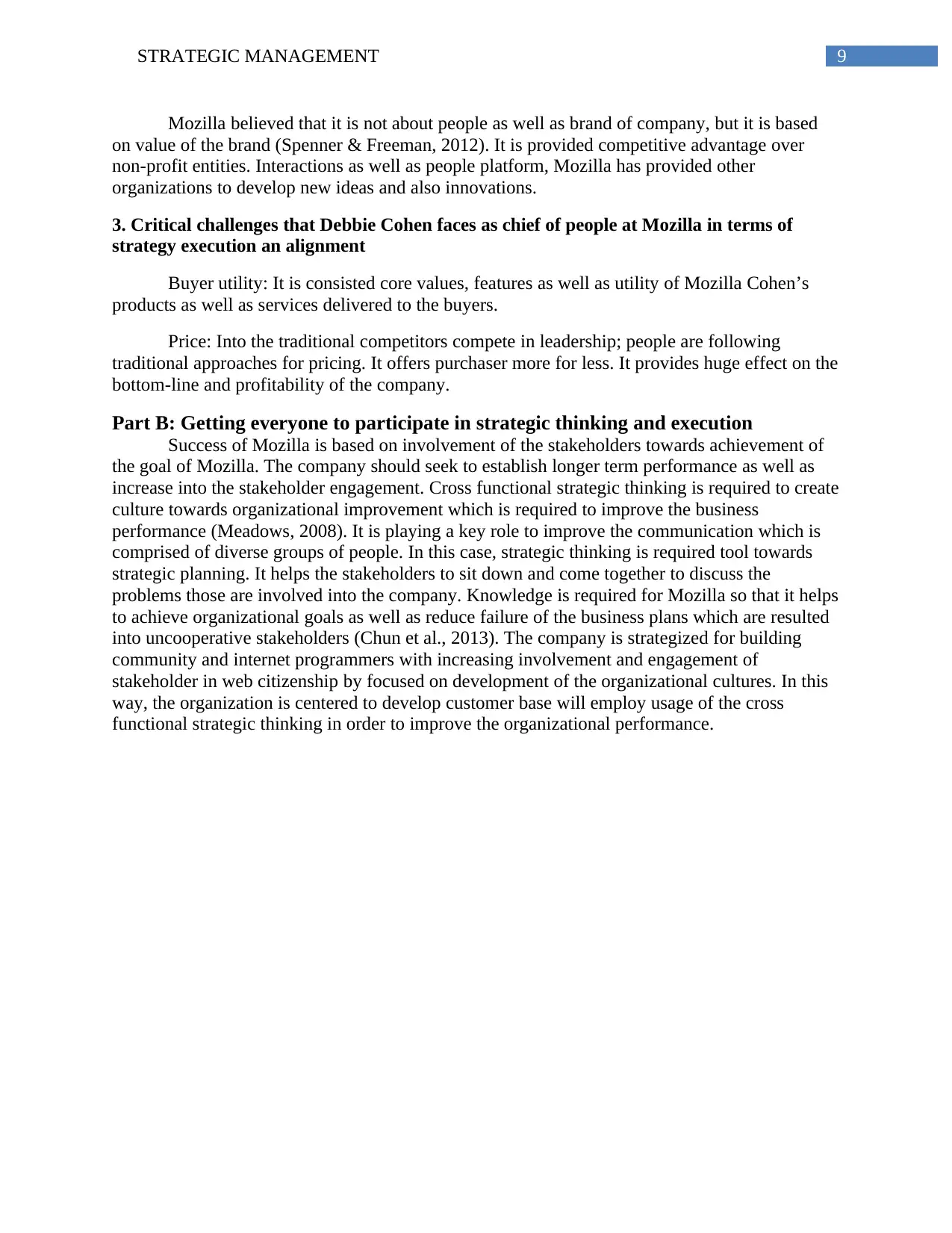
9STRATEGIC MANAGEMENT
Mozilla believed that it is not about people as well as brand of company, but it is based
on value of the brand (Spenner & Freeman, 2012). It is provided competitive advantage over
non-profit entities. Interactions as well as people platform, Mozilla has provided other
organizations to develop new ideas and also innovations.
3. Critical challenges that Debbie Cohen faces as chief of people at Mozilla in terms of
strategy execution an alignment
Buyer utility: It is consisted core values, features as well as utility of Mozilla Cohen’s
products as well as services delivered to the buyers.
Price: Into the traditional competitors compete in leadership; people are following
traditional approaches for pricing. It offers purchaser more for less. It provides huge effect on the
bottom-line and profitability of the company.
Part B: Getting everyone to participate in strategic thinking and execution
Success of Mozilla is based on involvement of the stakeholders towards achievement of
the goal of Mozilla. The company should seek to establish longer term performance as well as
increase into the stakeholder engagement. Cross functional strategic thinking is required to create
culture towards organizational improvement which is required to improve the business
performance (Meadows, 2008). It is playing a key role to improve the communication which is
comprised of diverse groups of people. In this case, strategic thinking is required tool towards
strategic planning. It helps the stakeholders to sit down and come together to discuss the
problems those are involved into the company. Knowledge is required for Mozilla so that it helps
to achieve organizational goals as well as reduce failure of the business plans which are resulted
into uncooperative stakeholders (Chun et al., 2013). The company is strategized for building
community and internet programmers with increasing involvement and engagement of
stakeholder in web citizenship by focused on development of the organizational cultures. In this
way, the organization is centered to develop customer base will employ usage of the cross
functional strategic thinking in order to improve the organizational performance.
Mozilla believed that it is not about people as well as brand of company, but it is based
on value of the brand (Spenner & Freeman, 2012). It is provided competitive advantage over
non-profit entities. Interactions as well as people platform, Mozilla has provided other
organizations to develop new ideas and also innovations.
3. Critical challenges that Debbie Cohen faces as chief of people at Mozilla in terms of
strategy execution an alignment
Buyer utility: It is consisted core values, features as well as utility of Mozilla Cohen’s
products as well as services delivered to the buyers.
Price: Into the traditional competitors compete in leadership; people are following
traditional approaches for pricing. It offers purchaser more for less. It provides huge effect on the
bottom-line and profitability of the company.
Part B: Getting everyone to participate in strategic thinking and execution
Success of Mozilla is based on involvement of the stakeholders towards achievement of
the goal of Mozilla. The company should seek to establish longer term performance as well as
increase into the stakeholder engagement. Cross functional strategic thinking is required to create
culture towards organizational improvement which is required to improve the business
performance (Meadows, 2008). It is playing a key role to improve the communication which is
comprised of diverse groups of people. In this case, strategic thinking is required tool towards
strategic planning. It helps the stakeholders to sit down and come together to discuss the
problems those are involved into the company. Knowledge is required for Mozilla so that it helps
to achieve organizational goals as well as reduce failure of the business plans which are resulted
into uncooperative stakeholders (Chun et al., 2013). The company is strategized for building
community and internet programmers with increasing involvement and engagement of
stakeholder in web citizenship by focused on development of the organizational cultures. In this
way, the organization is centered to develop customer base will employ usage of the cross
functional strategic thinking in order to improve the organizational performance.
Secure Best Marks with AI Grader
Need help grading? Try our AI Grader for instant feedback on your assignments.
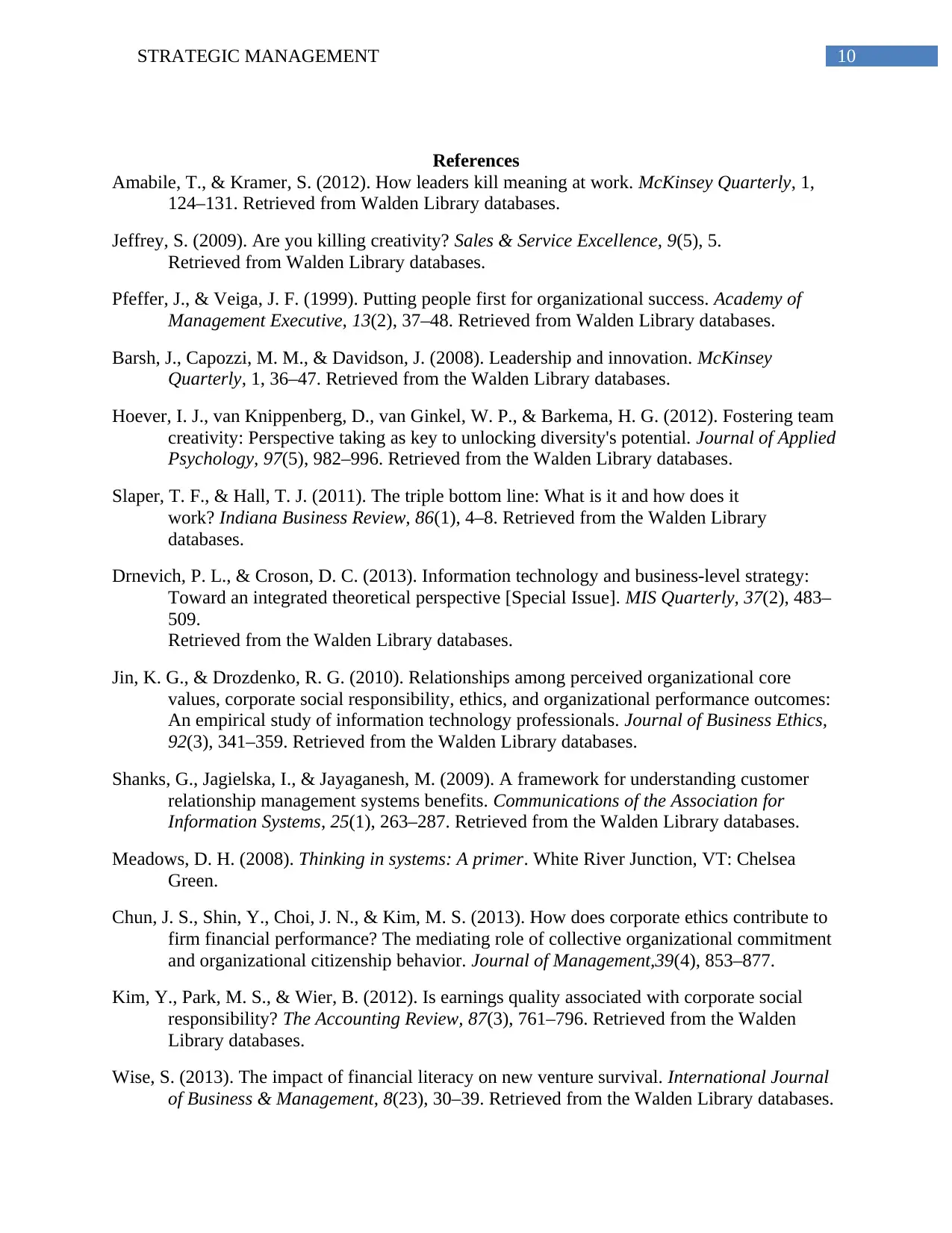
10STRATEGIC MANAGEMENT
References
Amabile, T., & Kramer, S. (2012). How leaders kill meaning at work. McKinsey Quarterly, 1,
124–131. Retrieved from Walden Library databases.
Jeffrey, S. (2009). Are you killing creativity? Sales & Service Excellence, 9(5), 5.
Retrieved from Walden Library databases.
Pfeffer, J., & Veiga, J. F. (1999). Putting people first for organizational success. Academy of
Management Executive, 13(2), 37–48. Retrieved from Walden Library databases.
Barsh, J., Capozzi, M. M., & Davidson, J. (2008). Leadership and innovation. McKinsey
Quarterly, 1, 36–47. Retrieved from the Walden Library databases.
Hoever, I. J., van Knippenberg, D., van Ginkel, W. P., & Barkema, H. G. (2012). Fostering team
creativity: Perspective taking as key to unlocking diversity's potential. Journal of Applied
Psychology, 97(5), 982–996. Retrieved from the Walden Library databases.
Slaper, T. F., & Hall, T. J. (2011). The triple bottom line: What is it and how does it
work? Indiana Business Review, 86(1), 4–8. Retrieved from the Walden Library
databases.
Drnevich, P. L., & Croson, D. C. (2013). Information technology and business-level strategy:
Toward an integrated theoretical perspective [Special Issue]. MIS Quarterly, 37(2), 483–
509.
Retrieved from the Walden Library databases.
Jin, K. G., & Drozdenko, R. G. (2010). Relationships among perceived organizational core
values, corporate social responsibility, ethics, and organizational performance outcomes:
An empirical study of information technology professionals. Journal of Business Ethics,
92(3), 341–359. Retrieved from the Walden Library databases.
Shanks, G., Jagielska, I., & Jayaganesh, M. (2009). A framework for understanding customer
relationship management systems benefits. Communications of the Association for
Information Systems, 25(1), 263–287. Retrieved from the Walden Library databases.
Meadows, D. H. (2008). Thinking in systems: A primer. White River Junction, VT: Chelsea
Green.
Chun, J. S., Shin, Y., Choi, J. N., & Kim, M. S. (2013). How does corporate ethics contribute to
firm financial performance? The mediating role of collective organizational commitment
and organizational citizenship behavior. Journal of Management,39(4), 853–877.
Kim, Y., Park, M. S., & Wier, B. (2012). Is earnings quality associated with corporate social
responsibility? The Accounting Review, 87(3), 761–796. Retrieved from the Walden
Library databases.
Wise, S. (2013). The impact of financial literacy on new venture survival. International Journal
of Business & Management, 8(23), 30–39. Retrieved from the Walden Library databases.
References
Amabile, T., & Kramer, S. (2012). How leaders kill meaning at work. McKinsey Quarterly, 1,
124–131. Retrieved from Walden Library databases.
Jeffrey, S. (2009). Are you killing creativity? Sales & Service Excellence, 9(5), 5.
Retrieved from Walden Library databases.
Pfeffer, J., & Veiga, J. F. (1999). Putting people first for organizational success. Academy of
Management Executive, 13(2), 37–48. Retrieved from Walden Library databases.
Barsh, J., Capozzi, M. M., & Davidson, J. (2008). Leadership and innovation. McKinsey
Quarterly, 1, 36–47. Retrieved from the Walden Library databases.
Hoever, I. J., van Knippenberg, D., van Ginkel, W. P., & Barkema, H. G. (2012). Fostering team
creativity: Perspective taking as key to unlocking diversity's potential. Journal of Applied
Psychology, 97(5), 982–996. Retrieved from the Walden Library databases.
Slaper, T. F., & Hall, T. J. (2011). The triple bottom line: What is it and how does it
work? Indiana Business Review, 86(1), 4–8. Retrieved from the Walden Library
databases.
Drnevich, P. L., & Croson, D. C. (2013). Information technology and business-level strategy:
Toward an integrated theoretical perspective [Special Issue]. MIS Quarterly, 37(2), 483–
509.
Retrieved from the Walden Library databases.
Jin, K. G., & Drozdenko, R. G. (2010). Relationships among perceived organizational core
values, corporate social responsibility, ethics, and organizational performance outcomes:
An empirical study of information technology professionals. Journal of Business Ethics,
92(3), 341–359. Retrieved from the Walden Library databases.
Shanks, G., Jagielska, I., & Jayaganesh, M. (2009). A framework for understanding customer
relationship management systems benefits. Communications of the Association for
Information Systems, 25(1), 263–287. Retrieved from the Walden Library databases.
Meadows, D. H. (2008). Thinking in systems: A primer. White River Junction, VT: Chelsea
Green.
Chun, J. S., Shin, Y., Choi, J. N., & Kim, M. S. (2013). How does corporate ethics contribute to
firm financial performance? The mediating role of collective organizational commitment
and organizational citizenship behavior. Journal of Management,39(4), 853–877.
Kim, Y., Park, M. S., & Wier, B. (2012). Is earnings quality associated with corporate social
responsibility? The Accounting Review, 87(3), 761–796. Retrieved from the Walden
Library databases.
Wise, S. (2013). The impact of financial literacy on new venture survival. International Journal
of Business & Management, 8(23), 30–39. Retrieved from the Walden Library databases.
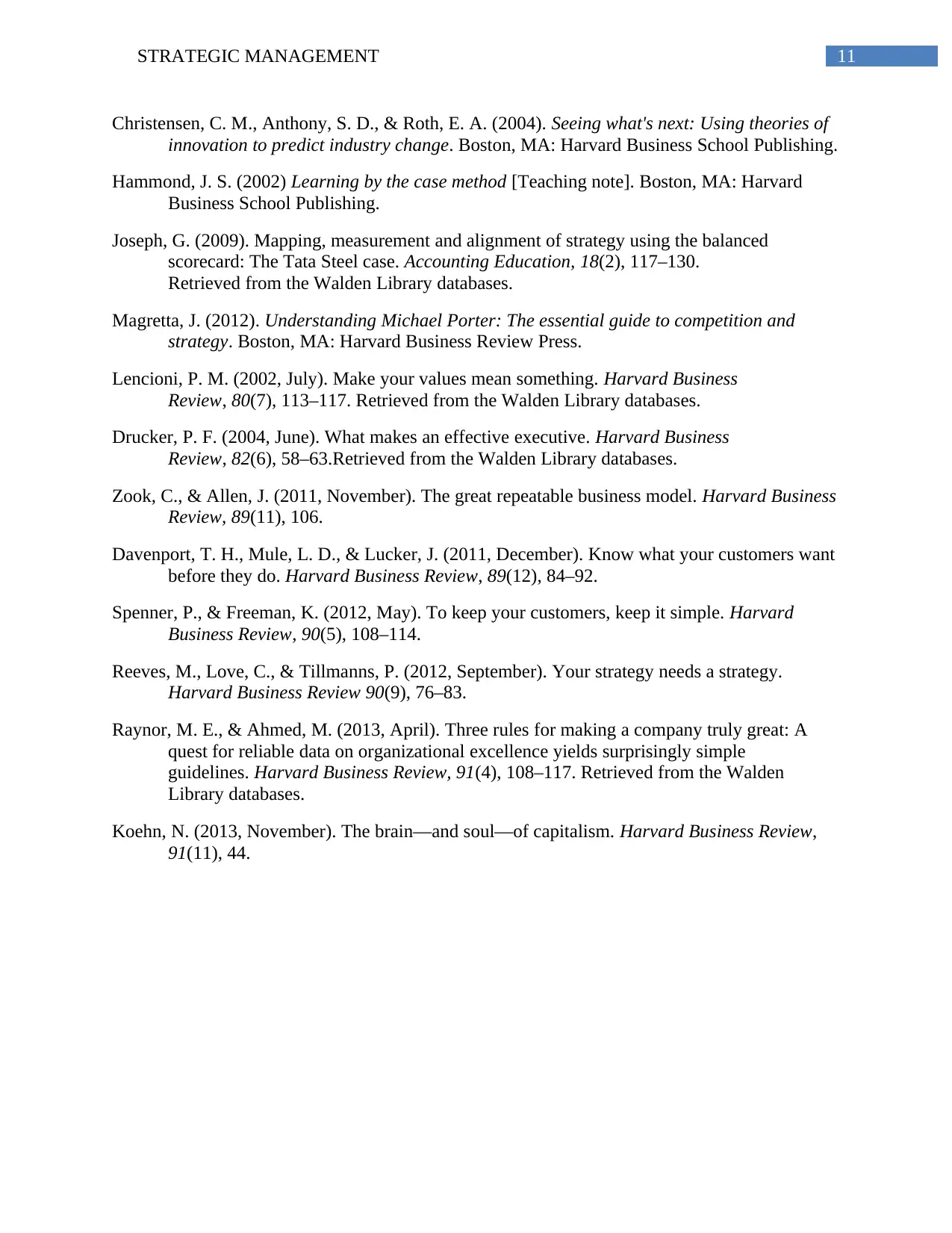
11STRATEGIC MANAGEMENT
Christensen, C. M., Anthony, S. D., & Roth, E. A. (2004). Seeing what's next: Using theories of
innovation to predict industry change. Boston, MA: Harvard Business School Publishing.
Hammond, J. S. (2002) Learning by the case method [Teaching note]. Boston, MA: Harvard
Business School Publishing.
Joseph, G. (2009). Mapping, measurement and alignment of strategy using the balanced
scorecard: The Tata Steel case. Accounting Education, 18(2), 117–130.
Retrieved from the Walden Library databases.
Magretta, J. (2012). Understanding Michael Porter: The essential guide to competition and
strategy. Boston, MA: Harvard Business Review Press.
Lencioni, P. M. (2002, July). Make your values mean something. Harvard Business
Review, 80(7), 113–117. Retrieved from the Walden Library databases.
Drucker, P. F. (2004, June). What makes an effective executive. Harvard Business
Review, 82(6), 58–63.Retrieved from the Walden Library databases.
Zook, C., & Allen, J. (2011, November). The great repeatable business model. Harvard Business
Review, 89(11), 106.
Davenport, T. H., Mule, L. D., & Lucker, J. (2011, December). Know what your customers want
before they do. Harvard Business Review, 89(12), 84–92.
Spenner, P., & Freeman, K. (2012, May). To keep your customers, keep it simple. Harvard
Business Review, 90(5), 108–114.
Reeves, M., Love, C., & Tillmanns, P. (2012, September). Your strategy needs a strategy.
Harvard Business Review 90(9), 76–83.
Raynor, M. E., & Ahmed, M. (2013, April). Three rules for making a company truly great: A
quest for reliable data on organizational excellence yields surprisingly simple
guidelines. Harvard Business Review, 91(4), 108–117. Retrieved from the Walden
Library databases.
Koehn, N. (2013, November). The brain—and soul—of capitalism. Harvard Business Review,
91(11), 44.
Christensen, C. M., Anthony, S. D., & Roth, E. A. (2004). Seeing what's next: Using theories of
innovation to predict industry change. Boston, MA: Harvard Business School Publishing.
Hammond, J. S. (2002) Learning by the case method [Teaching note]. Boston, MA: Harvard
Business School Publishing.
Joseph, G. (2009). Mapping, measurement and alignment of strategy using the balanced
scorecard: The Tata Steel case. Accounting Education, 18(2), 117–130.
Retrieved from the Walden Library databases.
Magretta, J. (2012). Understanding Michael Porter: The essential guide to competition and
strategy. Boston, MA: Harvard Business Review Press.
Lencioni, P. M. (2002, July). Make your values mean something. Harvard Business
Review, 80(7), 113–117. Retrieved from the Walden Library databases.
Drucker, P. F. (2004, June). What makes an effective executive. Harvard Business
Review, 82(6), 58–63.Retrieved from the Walden Library databases.
Zook, C., & Allen, J. (2011, November). The great repeatable business model. Harvard Business
Review, 89(11), 106.
Davenport, T. H., Mule, L. D., & Lucker, J. (2011, December). Know what your customers want
before they do. Harvard Business Review, 89(12), 84–92.
Spenner, P., & Freeman, K. (2012, May). To keep your customers, keep it simple. Harvard
Business Review, 90(5), 108–114.
Reeves, M., Love, C., & Tillmanns, P. (2012, September). Your strategy needs a strategy.
Harvard Business Review 90(9), 76–83.
Raynor, M. E., & Ahmed, M. (2013, April). Three rules for making a company truly great: A
quest for reliable data on organizational excellence yields surprisingly simple
guidelines. Harvard Business Review, 91(4), 108–117. Retrieved from the Walden
Library databases.
Koehn, N. (2013, November). The brain—and soul—of capitalism. Harvard Business Review,
91(11), 44.
1 out of 12
Your All-in-One AI-Powered Toolkit for Academic Success.
+13062052269
info@desklib.com
Available 24*7 on WhatsApp / Email
![[object Object]](/_next/static/media/star-bottom.7253800d.svg)
Unlock your academic potential
© 2024 | Zucol Services PVT LTD | All rights reserved.